Yaqui Wars
| Yaqui Wars | |||||||
|---|---|---|---|---|---|---|---|
| Part of the Mexican Indian Wars and the American Indian Wars | |||||||
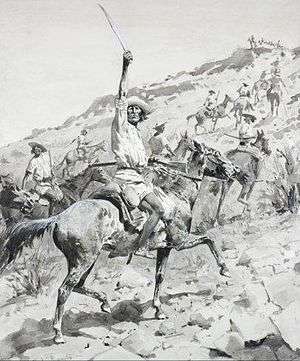 Uprising of the Yaqui Indians - Yaqui Warriors in Retreat, by Frederic Remington, 1896. | |||||||
| |||||||
| Belligerents | |||||||
|
(1533–1716) (1716–1821) (1821–1929) |
| ||||||
| Commanders and leaders | |||||||
|
|
| ||||||
The Yaqui Wars,[2] were a series of armed conflicts between New Spain, and the later Mexican republic, against the Yaqui Native Americans. The period began in 1533 and lasted until 1929. The Yaqui Wars, along with the Caste War against the Maya, were the last conflicts of the centuries long Mexican Indian Wars. Over the course of nearly 400 years, the Spanish and the Mexicans repeatedly launched military campaigns into Yaqui territory which resulted in several serious battles and some infamous massacres.[1][3]
Wars
18th century
The cause of the conflicts was like many of the Indian Wars in history, in 1684, the Spanish colonists in the present day Mexican state of Sonora, discovered silver in the Rio Yaqui Valley. Following this, the Spanish gradually began settling on Yaqui land and by 1740, the natives were ready to resist. Some minor conflicts from before dated back to 1533[1] but in 1740 the Yaquis united their tribe with the neighboring Mayo, Opata, and Pima natives and successfully drove the colonists out by 1742.
Juan Banderas
During the Mexican War of Independence from Spain (1810-1821) the Yaqui did not participate on either side. It was when Occidente passed a law in 1825 making the Yaqui its citizens and subjecting them to taxes that the Yaqui decided to go to war, since they had not previously been subjected to taxes. The first fighting was at Rahum. The movement was encouraged by Pedro Leyva, a Catholic priest and took the Virgin of Guadalupe as its symbol. The Yaqui coalesced around Juan Banderas as their leader. Banderas managed to get the Mayos, Opatas and Pimas to join in the war against the Mexican government. Occidente was so affected by the war that the capital was moved from Cosala to Fuerte. In 1827 Banderas' forces were defeated by Mexicans in the vicinity of Hermosillo. This defeat was partly due to the Yaquis having primarily bows and arrows, while the Mexicans had guns. After this defeat, Banderas negotiated a peace with Occidente, in which he was granted pardon, and recognized as captain-general of the Yaqui town, and was given a salary.[4]
In 1828 the office of captain-general was abolished, and Occidente government reasserted its right to tax the Yaqui, as well as proposing a plan for allotting the Yaqui lands. In 1832 Banderas renewed the war against the Mexican authorities, in cooperation with Dolores Guttierrez, a chief of the Opata.[5]
In 1833 Banderas and Guttierrez were executed after their forces were defeated in a battle near Buenavista, Mexico. There were other leaders who continued resisting, so the wars continued. One incident in 1868 was a massacre by Mexican soldiers of about 120 Yaqui men, women and children, after 600 had surrendered near Vícam. Some 400 of the Yaqui prisoners were held inside a church which was then bombarded by artillery. Affairs such as this drove many of the natives to emigrate, while others were deported by the Mexicans or enslaved.[6]
Mid-19th century resistance
Some warriors fled from their occupied pueblos along the Rio Yaqui and continued fighting in the Sierra Vakatetteve. In 1834 Yaqui at Torim tried to drive the Mexican settlers from that location. The Mexican forces in this fighting were led by a Yaqui, Juan Ignacio Juscamea. Juscamea continued to cooperate with the Mexican government until 1840 when he was killed by anti-Mexican Yaquis in fighting at Horcasitas.[7]
During the 1830s and 1840s the Yaqui often allied with Manuel Gándara in his struggle against José de Urrea for control of Sonora. In 1838 this led to Urrea capturing the coastal salt deposits of the Yaqui and transferring them to state control.[8]
In 1857 Gándara was removed from power by Ignacio Pesqueira. The Yaqui under the leadership of Mateo Marquin, also known as Jose Maria Barquin, were among the chief allies of Gándara in his attempt to regain control of Sonora. Initially most of the fighting was in the Guaymas River valley. However, in 1858 Cocorit became a point of violence. The Mayos joined the Yaqui in waging war against the Mexican government, and destroyed Santa Cruz, Sonora.[8]
On September 5, 1860, it was reported in Hermosillo that a Yaqui revolt had attained an importance which, during the week prior, would not have been conceived possible. Towards the end of August, bands of Yaqui and Mayo insurgents, some 1,000 or 1.200 strong, had marched towards Guaymas, burning and leveling Mexican settlements as they advanced. The citizens of Guaymas fortified the town, declaring it in a state of siege, and armed three hundred and fifty men in its defense. The Prefect of Guaymas dispatched a courier to the Governor, at Hermosillo, demanding additional aid. The dispatch reached Hermosillon at 2:00pm on the 31st of August. Governor Pesquiera, with a force of sixty horse and eighty infantry, promptly left Hermosillo, and was en route to El Cachora, intending to combine his forces with the three hundred additional troops he would find there. Unfortunately the Yaquis had spies as efficient as those of Government, and waited in ambush at Jacalitos, a small village about forty-two miles from Hermosillo, which proved very successful. The inexperienced Mexican troops who did not fall at the first attack fled the battle, leaving the Governor and General Angel Trias, of Chihuahua, who accompanied him, with some eight or ten of the body guard to face six hundred well armed Indians. Their horses were shot from under them, but they finally succeeded in escaping on animals captured from the enemy, and joined the forces at El Cachora. The few survivors from Jacalitos had not only lost their arms and baggage, but also the Seal of the State, all the Government stamped paper, and many important documents.[9] Following this defeat, Pesqueira invaded Mayo and Yaqui territory in 1862, and forced them to accept peace terms. The peace was negotiated at Torim, Sonora. The terms of the peace allowed a pardon to the leaders of the Yaqui, but required a military post to be established at Agua Caliente, Sonora, for the Mexicans to control the actions of the Yaqui.[8]
After the French victory over Pesqueira at Guaymas in 1865, the Yaqui allied with the French in fighting the Mexicans. Mateo Marquin publicly expressed support for the French. Refugio Tenori, a leader of the Opata, also allied with the French. These Native allies of the French took control of Alamos, Sonora, and drove Pesquira from his base at Ures, Sonora. In 1868, with the withdrawal of the French, Pesqueira appointed pro-Mexican Yaqui to administer the Yaqui towns, but in Bácum, Sonora the Yaqui murdered this official.[10] Not all the Yaqui sided with the French, Cajemé, for example, sided with Pesqueira and the Mexican government, and fought as a member of the Mexican forces.
Pesqueira then appointed Garcia Morales to lead a campaign against the Yaqui. At Cocorit they captured a large number of Yaqui, put them in a church and when they felt the Yaqui were not being cooperative enough fired artillery on the church causing a fire that killed 120 people. This was representative of the harsh military attacks on the Yaqui who accepted peace terms to avoid continued massacres.[11]
Cajemé
In 1874 Pesqueira appointed Cajemé as alcalde-mayor of all the towns of both the Yaqui and Mayo. José J. Pesqueira, son of the current governor, was designated successor to the governor. This caused an attempt to violently appoint a new governor, which Pesqueira reacted to by attacking Cajemé and his people. From Medano, Sonora, Pesqueira attacked a large number of Yaqui residents, killing Yaquis just because they were present, and pillaging their farms and ranches.[12]
In 1876 the Yaqui leader José Maria Leiva Peres, or Cajemé, established a small independent republic in Sonora. By then there were only about 4,000 "undefeated" Yaquis, and they attempted to defend their county by building the fortification called El Añil (The Indigo).
Agustin Ortiz, whose brother Carlos was then the governor of Sonora, led an attack from Navojoa to Capetemaya in 1882, with the intention of capturing Cajemé. Cajemé was wounded in the Battle of Capetemaya, but the forces of Ortiz were routed. Fighting in the Mayo territories continued until 1884 when they agreed to recognize Mexican authority. However Cajemé still insisted on his independence.
In 1885 Loreto Molino, a Yaqui who had previously been Cajemé's chief assistant, led a sea based raid from Guaymas against Cajemé's home which he burned, but Cajemé was in the south and survived.[13] This led to a resumption of full-scale war between the Yaqui and the Mexican government.
In May, 1886, the Mexican army began a series of military campaigns against the main Yaqui fortress of El Añil. El Añil was a fortification built near the village of Vícam, in the middle of a thick forest and on the left bank of the Yaqui river. The fortification consisted of a wide moat, which cut Torin path and behind a double lurch. Within the fortification lots of food and livestock were stockpiled, and to assure a source of water for the fortification, there was a large trench to the river that was over 700 meters long. There was also a wooden stockade with walls made of thick trunks of trees placed side by side, and woven with branches providing an enclosure where up to 4000 Yaqui people were protected.[14] General Marcos Carrillo, with 1,200 soldiers, initially attacked El Añil in a fierce battle to dislodge the indigenous Yaqui forces. General Angel Martinez brought up an additional 1,500 Mexican soldiers, and concentrated his forces to finish the campaign with a decisive blow. Under Colonel Lorenzo Torres, 300 soldiers surrounded the fort and fought against the Yaquis. During the battle that took place on May 12, 1886, the Yaquis fought back, but El Añil was captured. In the end only a few Yaqui soldiers escaped deep into the mountains, leaving 200 dead, and some 2,000 people, consisting primarily of the elderly, children, and the sick. The losses of the Mexican forces were 10 officers and 59 troops.[15] Following the battle, the people living in the villages of Huiviris, Potam, Bacum, Cócorit were amnestied by the Mexican government, in return for giving up their weapons. In return, the people in the villages were given clothes and food. However, few of Cajemé's men had handed in their weapons, not submitted to the government demands. Colonel Lorenzo Torres took l,500 Mexican soldiers, and went to El Medano, in order to attack and take over the Yaqui ordnance detachment, and provisions located there. However, Colonel Torres was forced to stop his march, after taking a toll of 62 dead from Yaqui sniper fire. The bulk of the remaining Yaqui soldiers were now unable to make war directly on Mexican military forces, so hid in the mountains, while being persecuted and systematically decimated. At this point, Cajemé sent a note to General Juan Hernandez saying"
"Desde luego nos someteremos todos a la obediencia del gobierno, bajo la condición de que dentro de 15 días se retiren todas sus fuerzas que están en el río Yaqui para Guaymas y Hermosillo, de no hacerlo así, pueden ustedes obrar de manera que les convenga; yo, en unión de mi nación, estoy dispuesto a hacer hasta la última defensa."
"We will all submit in obedience to government, under the condition that within 15 days [the government will] withdraw all their forces at the Rio Yaqui to Guaymas and Hermosillo. Failing to do so, you can act in a way that suits them [the government]. I, together with my nation, am willing to continue [fighting] until the last defense."
Nearly one year later Cajemé was captured in the village of San José de Guaymas, about 10 miles outside of the Port of Guaymas. Cajemé was eventually transported to the mouth of the Yaqui river, and paraded through many of the Yaqui villages to show that he had been captured. On April 23, 1887, Cajemé was executed at a place called Tres Cruces de Chumampaco. Juan Maldonado took Cajemé's place, and continued a guerrilla war in the Sierra del Bacatete. The Yaqui towns along the Rio Yaqui became mostly deserted, with many of the inhabitants fleeing into the surrounding mountains, and to other states in Mexico, including Chihuahua and Sinaloa.
Yaqui Uprising
In February 1896 an event known as the Yaqui Uprising began after the Mexican revolutionary Lauro Aguirre drafted a plan to overthrow the government of Porfirio Díaz. Aguirre and his men were able to convince several Yaqui and Pima natives to join in the revolt so on August 12 a combined force of no less than seventy men attacked the customs house at Nogales, Sonora. A battle then ensued which left at least three people dead and many more wounded. During the fight a group of American militia formed in the adjoining town of Nogales, Arizona and they assisted the Mexican defenders in repelling the rebels' attack. Ultimately the Yaquis and the others were obliged to withdraw from the area, ending the uprising and leading to a United States Army operation to track the hostiles. Two companies of the 24th Infantry Regiment were assigned to hunt the rebels who were being pursued by troops of the Mexican Army Colonel Emilio Kosterlitsky. However, the rebels got away, some escaped to Arizona. In 1897 a peace treaty was signed in Ortiz between the Yaquis and the Mexican government but in 1899 another serious outbreak of hostilities began and it led to the bloody Mazocoba Massacre of 1900, in which several hundred natives were killed.[6][16][17][18][19][20][21] Manuel Balbás wrote in Recuerdos del Yaqui how some Yaqui's at Mazocoba survived combat, but chose to take their own life, either with their own weapons, or by throwing themselves from the cliffs rather than surrender to the enemy. One event in which a young woman who had been hiding but was discovered, without a tear in her eyes, "approached the body of her loved one, knelt a moment, bowed slightly, and perhaps for a last time looked at the face of the beloved, and arose at once, quickly running like a gazelle toward the precipice, and without a moment's hesitation , plunged into the abyss."[22] It was at this point in time, in the late 1890s and early years of the 1900s, that a large number of Yaqui people began traveling north to settle in the United States around Tucson and Phoenix, Arizona, and into parts of Texas, including the El Paso area, as well as the Lubbock area, where a group of Yaqui refugees had settled years earlier.
Later developments
.jpg)
Around this time Porfirio Díaz began advocating for a solution to the Yaqui wars. By 1903 the decision was made to deport both the peaceful and rebellious Yaqui natives to the Yucatan and Oaxaca. Meanwhile, from 1904 to 1909, the Mexican governor of Sonora, Rafael Izábal, led "organized manhunts" in which about 8,000 to 15,000 Yaquis were taken prisoner and "virtually enslaved". Following the outbreak of the Mexican Revolution in 1910, Yaqui warriors joined all of the armies of the major rebel factions. They also began resettling their ancestral lands along the Rio Yaqui. In 1911, Diaz was exiled and President Francisco Madero took office. He is said to have promised the Yaqui people compensation for their losses but by 1920, when the main phase of the war ended, the promises were forgotten. By 1916, Mexican generals, such as Alvaro Obregon, began establishing estates on Yaqui land during the revolution and this led to renewed hostilities between the natives and the military.[6]
It was during this period of the conflict that the United States Army fought the last battle of the American Indian Wars. In January 1918, a small group of about thirty natives were intercepted by Buffalo Soldiers of the 10th Cavalry, just across the international border, near Arivaca, Arizona. In the thirty-minute skirmish that followed, the Yaqui commander was killed and a handful of others were taken prisoner. The last major engagement of the Yaqui Wars came almost ten years later in 1927 at the Battle of Cerro del Gallo (Hill of the Rooster). It was reported in the Mexican newspaper El Universal that because the Yaqui had withdrawn in the mountains, the Mexican Federal Staff had decided to undertake a major offensive against them. Operations would be directed by General Obregón, assisted by the General Manzo.[23] According to another report published on October 5, 1927, 12,000 "federales" were soon to present in the state of Sonora, equipped with 8mm machine guns, airplanes and poison gas.[24] On October 2, 1927, the Los Angeles Times reported that General Francisco R. Manzo, Commander of the federal forces in Sonora, had informed President Calles that he expected the Yaqui chieftain, Luis Matius, would soon surrender after holding out in the Bacatete Mountains for more than a year.[25][26] After that some minor warfare continued into 1929 but the violence was quelled mainly by bombings from the Mexican Air Force. The Mexican Army also established posts at all of the Yaqui settlements and this action prevented future conflict.[1][3][6]
Gallery
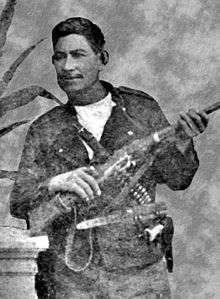 The Yaqui warrior Cajemé in April 1887, taken at the time of his arrest by Mexican authorities.
The Yaqui warrior Cajemé in April 1887, taken at the time of his arrest by Mexican authorities.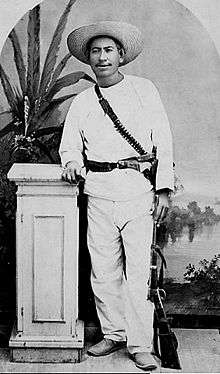 Cajemé under arrest at Guaymas in April 1887.
Cajemé under arrest at Guaymas in April 1887.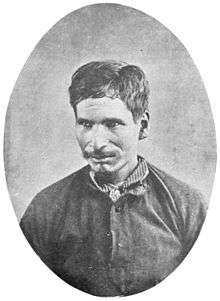 The Yaqui leader Anastacio Cuca in May 1887.
The Yaqui leader Anastacio Cuca in May 1887.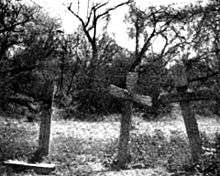 Tres Cruces de Chumampaco in 1895, where Cajemé was killed.
Tres Cruces de Chumampaco in 1895, where Cajemé was killed.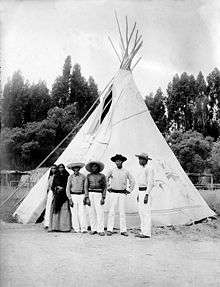 Yaqui people, circa 1910.
Yaqui people, circa 1910. General Alvaro Obregon and his staff of Yaquis, sometime between 1910 and 1915.
General Alvaro Obregon and his staff of Yaquis, sometime between 1910 and 1915..jpg) A group of more than 30 Yaqui Indian prisoners being escorted away by Mexican soldiers, Mexico, ca.1910
A group of more than 30 Yaqui Indian prisoners being escorted away by Mexican soldiers, Mexico, ca.1910.jpg) A group of more than 30 women and children Yaqui Indian prisoners under guard, Guaymas, Mexico, ca.1910
A group of more than 30 women and children Yaqui Indian prisoners under guard, Guaymas, Mexico, ca.1910.jpg) A group of Yaqui Indians, including Chief Talaviate, at the surrender and signing of peace treaty at Ortiz, Mexico, ca.1910
A group of Yaqui Indians, including Chief Talaviate, at the surrender and signing of peace treaty at Ortiz, Mexico, ca.1910
See also
- Pascua Yaqui Tribe
- Texas Band of Yaqui Indians
- Renegade period
- Mexican Apache Wars
- Mexican Comanche Wars
References
| Library resources about Yaqui Wars |
- 1 2 3 4 es:Guerra del Yaqui
- ↑ Orientation - Yaqui
- 1 2 Yaqui history: A Short History
- ↑ Edward H. Spicer, Cycles of Conquest (Tucson: University of Arizona Press, 1962) p. 60-61
- ↑ Spicer, Cycles of Conquest, p. 62
- 1 2 3 4 A Short History of the Yaqui Indians by Edith te Wechel
- ↑ Spicer, Cycles of Conquest, p. 64
- 1 2 3 Spicer, Cycles of Conquest, p. 65
- ↑ "From Sonora: The Correspondent of the Bulietin [Official State newspaper of Sonora]". Sacramento Daily Union, Volume 20, Number 2974. 8 October 1860. Retrieved February 3, 2014.
- ↑ Spicer, Cycles of Conquest, p. 66
- ↑ Spicer, Cycles of Conquest, p. 67
- ↑ Spicer, Cycles of Conquest, p. 68
- ↑ Spicer, Cycles of Conquest, p. 71
- ↑ Troncoso (Francisco de Borja del Paso y Troncoso), pp. 117-124
- ↑ Troncoso, pp.124-129
- ↑ Garcia, pg. 173-176
- ↑ Ruiz, pg. 97-117
- ↑ URREA, TERESA | The Handbook of Texas Online| Texas State Historical Association (TSHA)
- ↑ Johnson, pg. 664-665
- ↑ Garza, pg. 40-41
- ↑ Huachuca Illustrated, vol 1, 1993: Fort Huachuca: The Traditional Home of the Buffalo Soldier
- ↑ Manuel Balbás, Recuerdos del Yaqui: Principales Episodios Durante la Campaña de 1899 a 1901 (Mexico City: Sociedad de Edition y Liberia Franco Americana, 1927) p. 58
- ↑ El Universal, September 28, 1927
- ↑ El Universal, October 05, 1927
- ↑ "Surrender Due in Yaqui Strife: Leader Expected to Accept Mexican Terms Today," Los Angeles Times, October 2, 1927.
- ↑ "Yaqui War Near End: Final Chapter of Century of Strife May be Written with Chief's Surrender". Lawrence Daily Journal-World. September 30, 1927. Retrieved 2013-08-01.
Bibliography
- Garcia, Mario T. (1981). Desert Immigrants: The Mexicans of El Paso, 1880-1920. Yale University Press. ISBN 0-300-02520-3.
- Garza, Hedda (1994). Latinas: Hispanic women in the United States. University of New Mexico Press. ISBN 0-8263-2360-X.
- Johnson, Alfred S.; Clarence A. Bickford (1896). The Cyclopedic review of current history, Volume 6. Garretson, Cox & Co.
- Ruiz, Vicki; Virginia Sánchez Korrol (2005). Latina legacies: identity, biography, and community. Oxford University Press. ISBN 0-19-515399-5.
- Troncoso, Francisco P. (1905). Las guerras con las Tribus Yaqui y Mayo del estado de Sonora, Mexico.. Mexico: Tipografia del departamento de estado mayor. External link in
|title=(help)